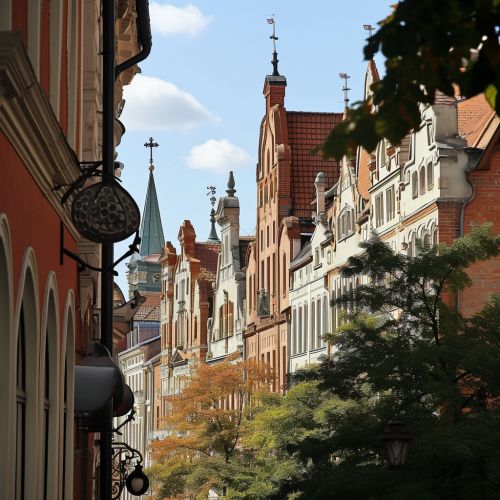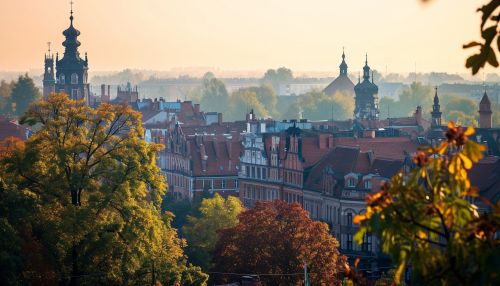Gliwice
History
Gliwice, known in German as Gleiwitz, is a city in Upper Silesia, southern Poland. The city's history dates back to the 13th century, when it was first mentioned in written documents in 1276, although archaeological evidence suggests human habitation in the area as far back as the Stone Age. The city's growth was largely due to its location on the trade routes connecting Western and Eastern Europe, and its proximity to the Oder and Vistula rivers.


In the Middle Ages, Gliwice was a part of the Kingdom of Bohemia, under the rule of the Luxembourg dynasty. The city was granted town rights in 1276 by King Ottokar II of Bohemia, and it quickly developed into a significant commercial center. The city's coat of arms, featuring a golden lion on a blue background, was granted in 1299 and is a reference to the Luxembourg dynasty.
In the 16th century, Gliwice became a part of the Habsburg Monarchy as a result of the Austrian War of Succession. During this period, the city experienced significant growth, particularly in the areas of trade and crafts. The city's infrastructure was also improved, with the construction of new roads and bridges.
In the 18th century, Gliwice was annexed by the Kingdom of Prussia during the Silesian War. The city became a part of the German Empire in 1871, and it remained under German rule until the end of World War II.
During the 19th century, Gliwice experienced rapid industrialization, becoming one of the most important industrial centers in the region. The city's economy was primarily based on coal mining, steel production, and machinery manufacturing.
The interwar period was a time of significant change for Gliwice. The city was heavily affected by the Great Depression, which led to high unemployment rates and economic instability. However, the city managed to recover and continue its industrial development.
During World War II, Gliwice was the site of the Gleiwitz Incident, a staged attack on the radio station by Nazi forces, which served as a pretext for the invasion of Poland. After the war, the city was incorporated into Poland, and its German population was expelled.
In the post-war period, Gliwice underwent significant changes. The city's industry was nationalized, and it became a major center for heavy industry in the newly established People's Republic of Poland. The city also experienced a population boom, as people from other parts of Poland and from the former eastern territories of Poland moved to Gliwice.
Today, Gliwice is a vibrant city with a rich history and a thriving economy. The city is home to several universities, including the Silesian University of Technology, and it is a major center for science and research in Poland.
Geography
Gliwice is located in the southern part of Poland, in the Upper Silesian Industrial Region. The city is situated on the Kłodnica River, a tributary of the Oder River. The city's geographical location, in the heart of Europe, has played a significant role in its development and history.
The city's landscape is largely flat, with an average elevation of 220 meters above sea level. The highest point in the city is the Płóczki hill, which reaches a height of 274 meters.
Gliwice's climate is classified as a temperate continental climate, with warm summers and cold winters. The city experiences a significant amount of precipitation throughout the year, with the highest rainfall occurring in the summer months.
The city is surrounded by several nature reserves, including the Silesian Park, which is one of the largest urban parks in Europe. The park is home to a variety of plant and animal species, and it is a popular destination for locals and tourists alike.
Economy
Gliwice's economy is diverse and robust, with a strong focus on industry, science, and education. The city is home to several large companies, including the car manufacturer Opel, which operates one of its largest production plants in Europe in Gliwice.
The city's industrial sector is dominated by the automotive industry, but it also includes other sectors such as machinery manufacturing, chemical production, and food processing. The city is also a major center for logistics, with several large distribution centers located in the area.
In addition to its industrial sector, Gliwice is also a major center for science and research. The city is home to several universities and research institutions, including the Silesian University of Technology, which is one of the top technical universities in Poland.
The city's economy is also supported by its strong service sector, which includes sectors such as retail, healthcare, and education. The city's vibrant cultural scene, with its numerous museums, theaters, and festivals, also contributes to the local economy.
Culture
Gliwice has a rich cultural scene, with numerous cultural institutions and events. The city is home to several museums, including the Gliwice Museum, which houses a collection of artifacts related to the city's history and culture.
The city's cultural scene is also enriched by its numerous theaters, including the Gliwice Theater, which hosts a variety of performances, including plays, operas, and ballets. The city also hosts several music festivals throughout the year, including the Gliwice Jazz Festival and the Gliwice Rock Festival.
Gliwice is also known for its architectural heritage, which includes a variety of architectural styles, from Gothic to Modernist. The city's Old Town is particularly notable, with its well-preserved medieval buildings and charming cobblestone streets.
